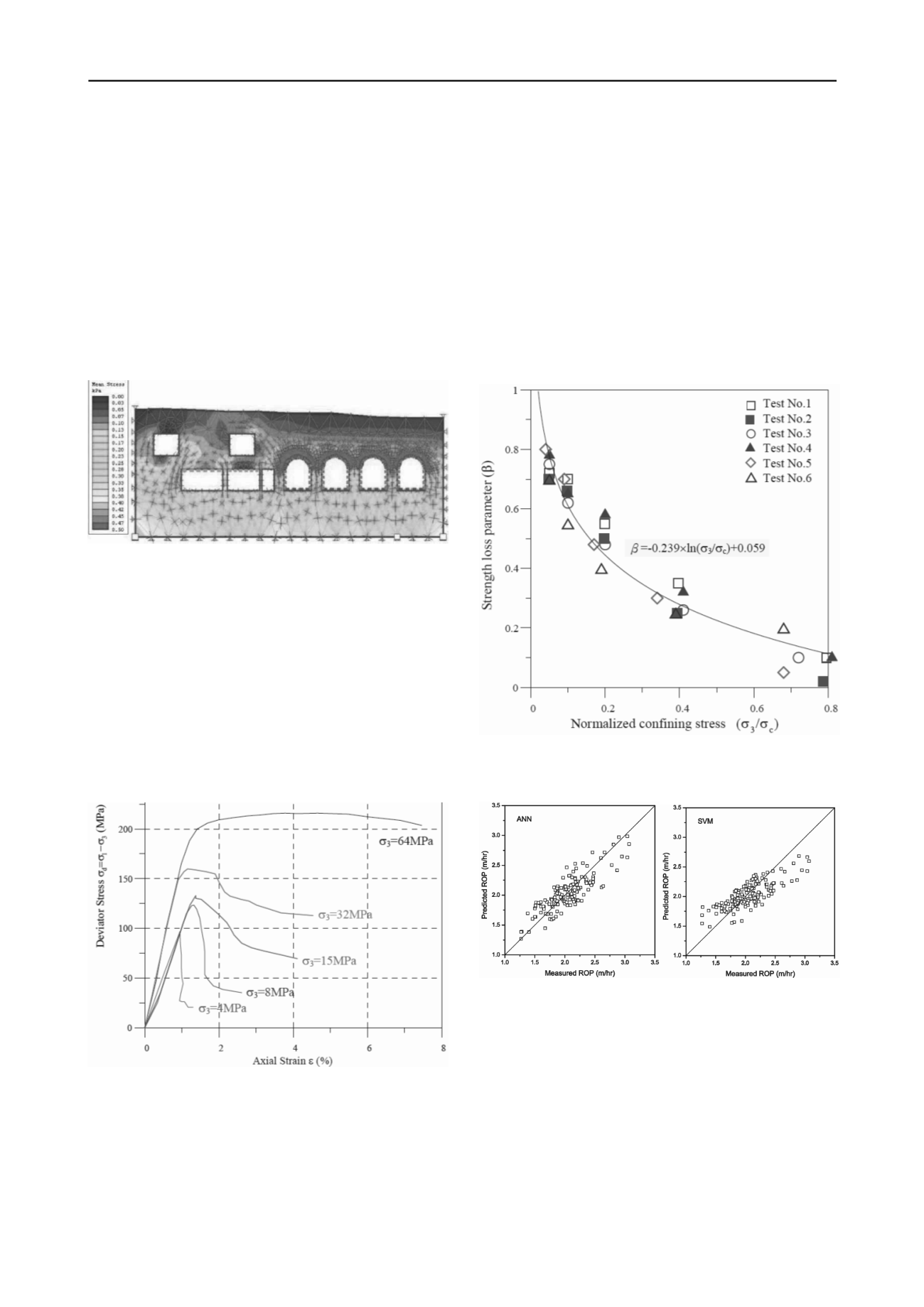
1678
Proceedings of the 18
th
International Conference on Soil Mechanics and Geotechnical Engineering, Paris 2013
5 ROCK TUNNELLING
This topic gathered three papers of underground structures
excavated in different types of rock. Stability of underground
structures with different geometries and with account for post-
peak strength degradation is presented. An empirical method for
the prediction of TBM penetration rate is also presented.
Görög
et al.
perform several numerical analyses with four
different codes of underground cellars beneath the city of
Budapest, in their paper “Stability analyses of underground
structures cut into porous limestone”. The results focus on
admissible surface loads, grouting and enlargement of a tunnel
and interaction of different cellar systems, as in Figure 15. The
restrictions and capabilities of each modelling tool are depicted
and analysed in the results and conclusion.
Figure 15. Mean stress distribution around the interacting cellars
(modified from Görög
et al.
).
Hsiao and Chi
in their paper “Effect of brittle failure on
deep underground excavation in eastern Taiwan” investigate
how post-peak strength degradation of metamorphic hard rock
in Taiwan can affect deep tunnelling behaviour. The case study
of a twin-hole tunnel with an excavation span of 12.5 m was
studied with a finite difference package.
The study evaluated the tunnel at two different depths, 500
and 1000 m, and the rock mass by two different models, the
Hoek-Brown model and the Hoek-Brown with the post peak
degradation model of Cundall
et al.
(2003). A subroutine was
created to account for the strength loss parameter as a function
of the confining stress, adjusted from several tri-axial
compressive tests (Figure 16).
Figure 16. Typical stress-strain curves of triaxial tests under different
confining stresses from the marbles in eastern Taiwan (modified from
Hsiao and Chi).
This model diminishes the peak parameters by a factor of (1-
β), β being the strength loss parameter that decreases with
increasing
3
/
c
as in Figure 17.
The analyses show that the increase in tunnel deformations
due to deeper excavation is more pronounced when the
evolution of post-peak strength degradation with confinement
loss due to tunnelling is accounted for. With a 1000 m depth the
roof settlements can be three times larges when accounting for
post-peak strength degradation.
Martins and Miranda
in their paper “Prediction of hard
rock TBM penetration rate based on Data Mining techniques”
apply artificial neural networks (ANN) and support vector
machine algorithms (SVM) on a database of rock properties and
TBM penetration rate (ROP) to evaluate the relative impact of
each rock parameter on the ROP. The artificial neural network
algorithm resulted in more accurate predictions, as it can be
seen in Figure 18. For this database that only included fractured
rock masses, the PSI parameter that quantify the brittleness and
toughness of the rock was the most influential parameter. On
the other hand the uniaxial compressive strength was the least
influential one. On a rock mass with less joints and faults one
could expect a different scenario.
Figure 17. Correlation between the strength loss parameter and the
normalized confining stress for the marbles in eastern Taiwan (after
Hsiao and Chi).
Figure 18. Comparison between the measured and predicted ROP for
the ANN and the SVM models (after Martins and Miranda).
A reader of this topic that is mostly familiar with soft soil
tunneling will be able to take a brief look at the challenges and
interesting approaches that pervade rock tunneling. A solid
study of constitutive modeling for special rock conditions is
given by
Hsiao and Chi,
in the general rock mechanics sense
and applied to tunnel case studies.
6 SEISMIC ANALYSIS OF TUNNELS
al models
an
Three papers were classified under this topic. Analytic
d numerical models were derived based on in situ testing,
model tests and real cases. There are also some interesting


